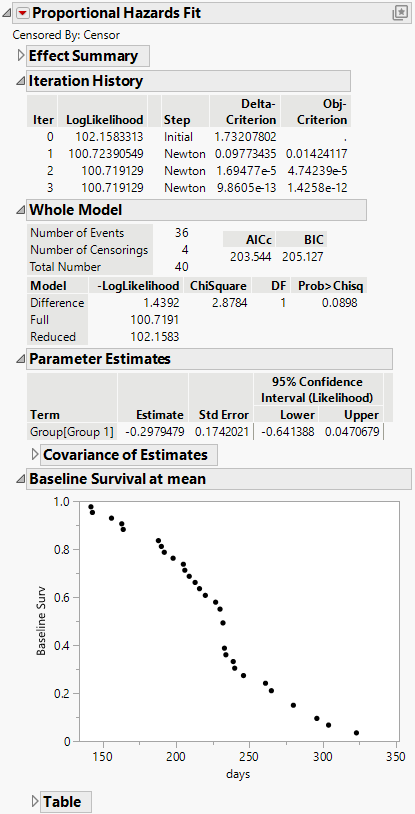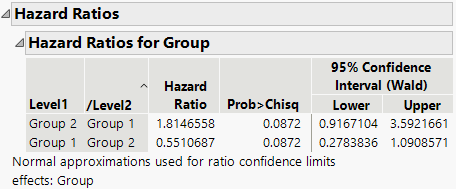Example of the Fit Proportional Hazards Platform
This example illustrates one nominal effect with two levels. For an example with multiple effects and multiple levels, see Additional Example of the Fit Proportional Hazards Platform.
1. Select Help > Sample Data Folder and open Rats.jmp.
2. Select Analyze > Reliability and Survival > Fit Proportional Hazards.
3. Select days and click Time to Event.
4. Select Censor and click Censor.
5. Select Group and click Add.
6. Click Run.
Figure 17.2 Proportional Hazards Fit Report for Rats.jmp Data
In the Rats.jmp data, there are only two groups. Therefore, in the Parameter Estimates report, a confidence interval that does not include zero indicates an alpha-level significant difference between groups. Also, in the Effect Likelihood Ratio Tests report, the test of the null hypothesis for no difference between the groups shown in the Whole Model Test table is the same as the null hypothesis that the regression coefficient for Group is zero.
Hazard Ratios for One Nominal Effect with Two Levels
To show hazard ratios for effects, select the Hazard Ratios option from the red triangle menu. In this example, there is only one effect, and there are only two levels for that effect. The hazard ratio for Group 2 is compared with Group 1 and appears in the Hazard Ratios for Group report. See Figure 17.3. The hazard ratio in this table is determined by computing the exponential of the parameter estimate for Group 2 and dividing it by the exponential of the parameter estimate for Group 1.
Note the following:
• The Group 1 parameter estimate appears in the Parameter Estimates table (Figure 17.2).
• The Group 2 parameter estimate is calculated by taking the negative value for the parameter estimate of Group 1.
• Reciprocal shows the value for 1/Hazard Ratio.
Tip: To see the Reciprocal values, right-click in the Hazard Ratios report and select Columns > Reciprocal.
For this example, the hazard ratio for Group2/Group1 is calculated as follows:
exp[-(-0.2979479)] /exp(-0.2979479) = 1.8146558
This hazard ratio value suggests that the risk of death for Group 2 is 1.81 times that for Group 1.
Figure 17.3 Hazard Ratios for Group Table
For information about calculating hazard ratios when there are multiple effects, or categorical effects with more than two levels, see Hazard Ratios for Multiple Effects and Multiple Levels.

